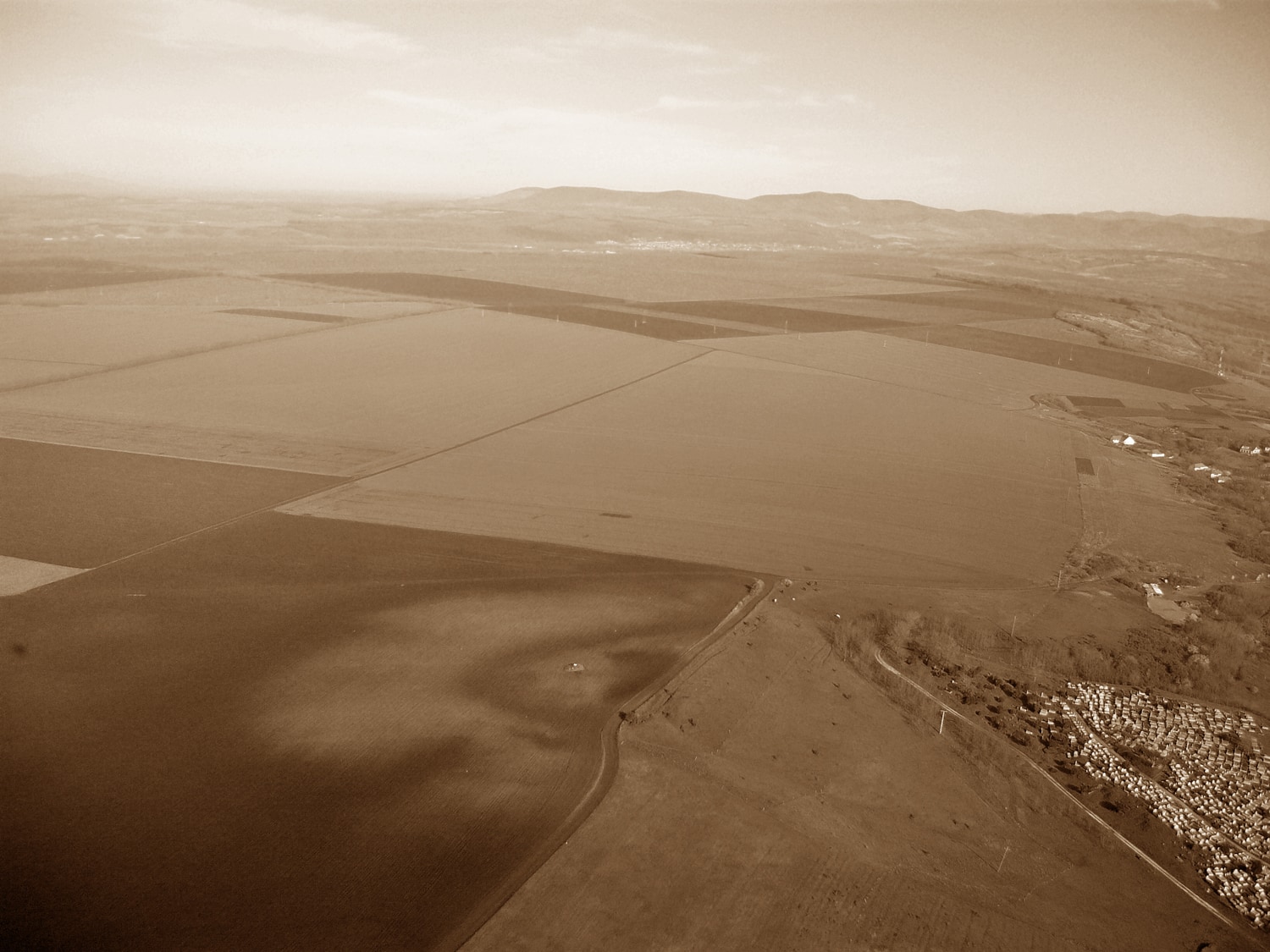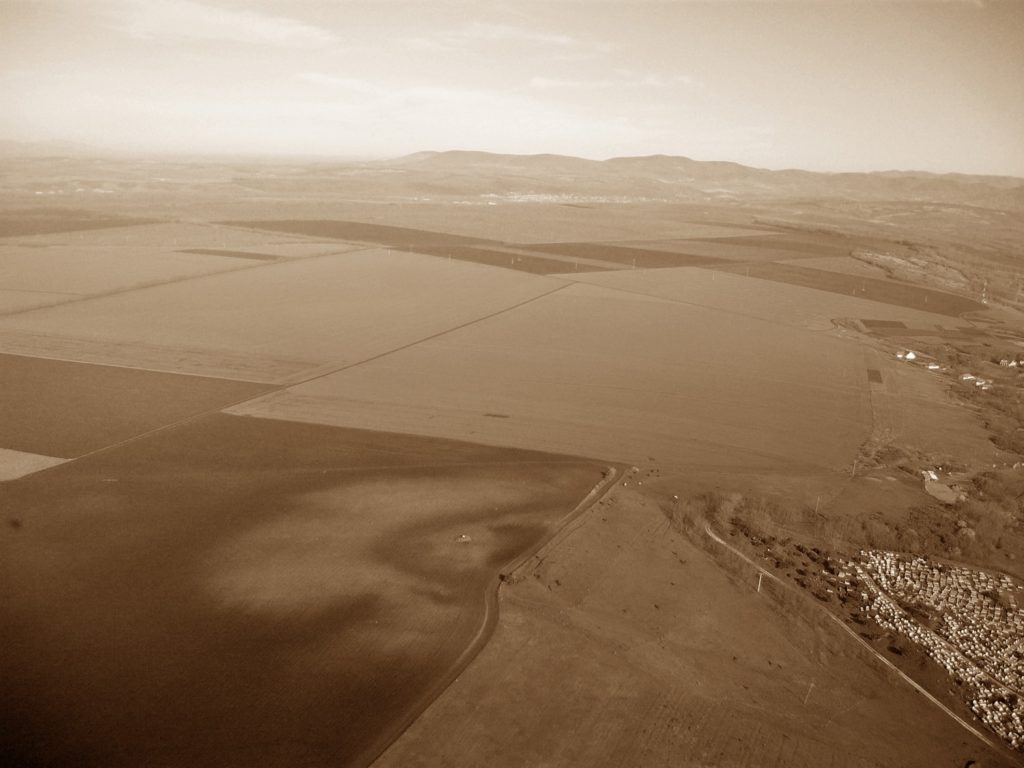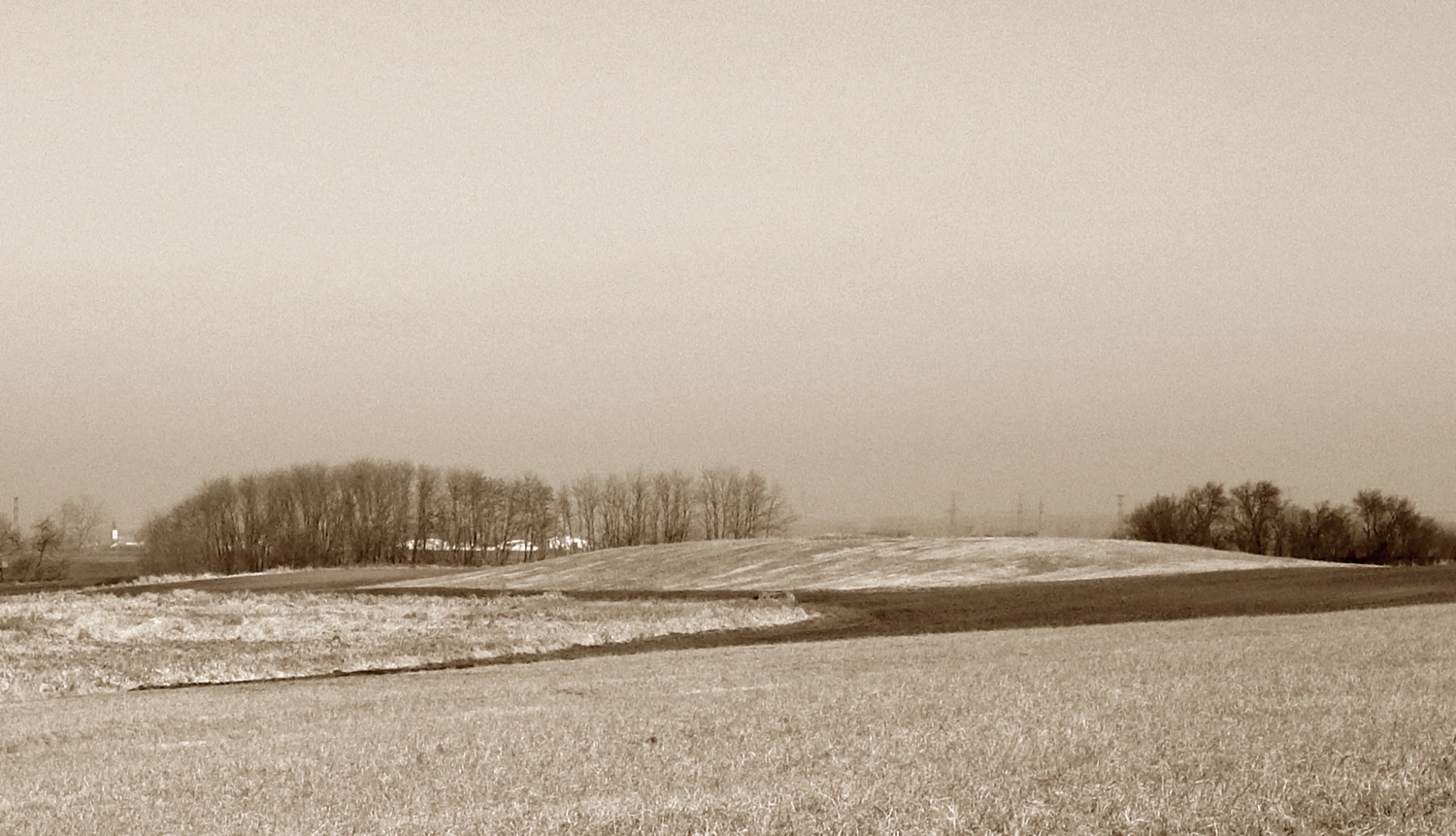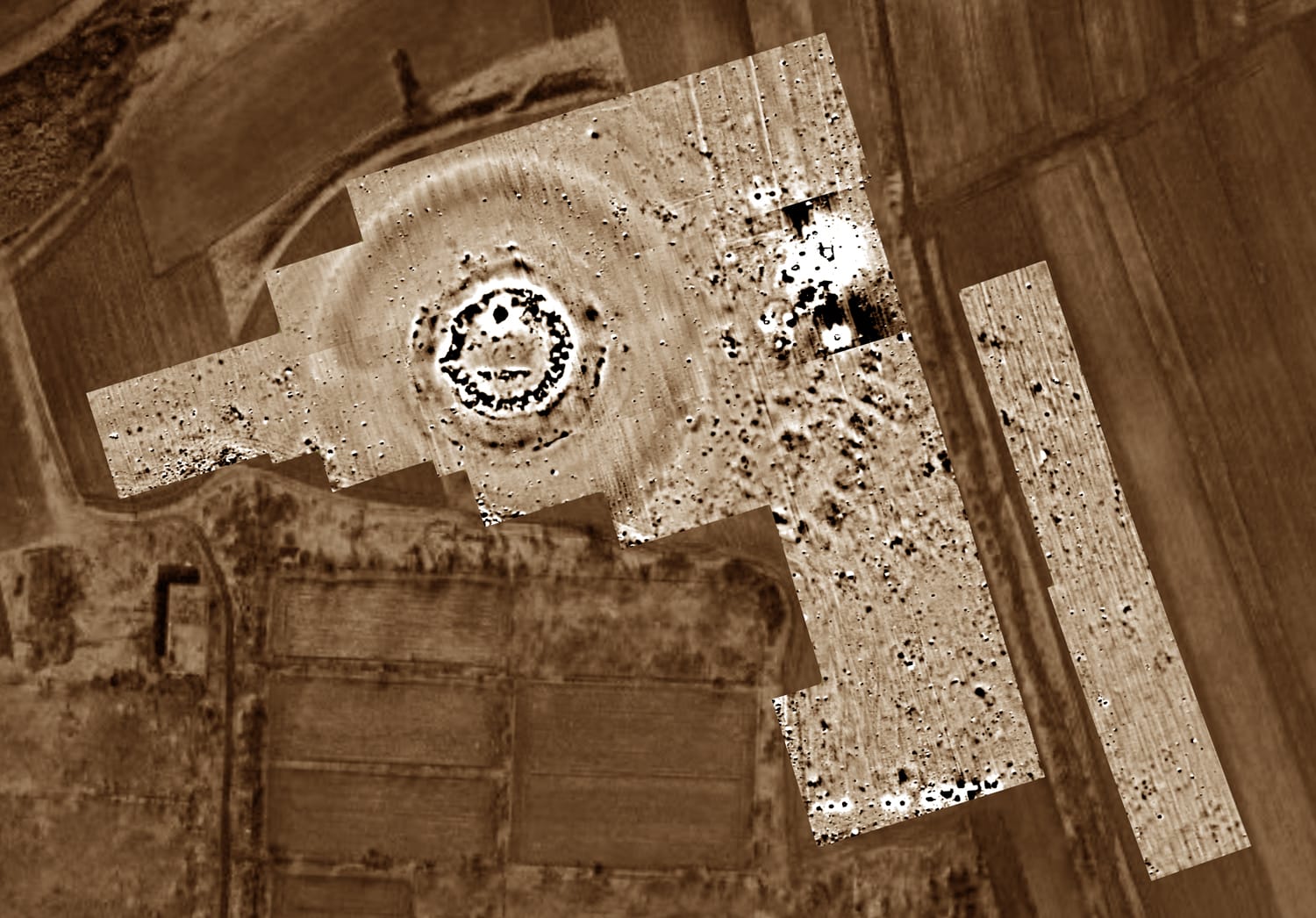The tell-like settlement of Tard (Hu)
The lighter soil colour in the foreground stems from the cultural layers of the archaeological site. The Bükk mountains rise on the horizon. On the right edge of the picture there is the cemetery of the modern village.


The tell-like settlement of Tard (Hu)
The lighter soil colour in the foreground stems from the cultural layers of the archaeological site. The Bükk mountains rise on the horizon. On the right edge of the picture there is the cemetery of the modern village.

Specifically, the foundation’s purpose is to further the preservation and archaeological research of prehistoric settlement mounds (tells) in the Old World, including their surrounding outer settlements and settlement systems as well as associated cultural phenomena such as cemeteries, etc.
Apart from fieldwork, the processing and publication of pertinent data, theoretical work is particularly eligible for support that, from a perspective of cultural studies, deals with the understanding of the specific constancy of place and the reference to tradition, the specific materiality and the organisation of social space of prehistoric tell cultures.
The tell of Szakáld
(Hu)
The gentle elevation on the river bank of the old bed of the Kerengö stream indicates the remains of the Bronze Age settlement.


The tell of Szakáld (Hu)
The gentle elevation on the river bank of the old bed of the Kerengö stream indicates the remains of the Bronze Age settlement.
carrying out archaeological fieldwork and its evaluation including the application of relevant scientific methods (environmental reconstruction, geophysical prospecting, C14 dating, etc.),
…
acquisition and long-term maintenance of land and protection of prehistoric tell settlements (possibly including their outer settlement),
…
implementation of protective measures for archaeological sites of settlement mounds (possibly including their outer settlement), for example long-term leasing or compensation to farmers to remove land from agricultural use,
…
promotion of the application and development of non-destructive methods in tell research (geophysics, drilling, etc.),
…
funding of research projects and work by domestic and foreign scholars who, with an explicitly theoretical orientation and the perspective of cultural studies, devote themselves to the understanding of the characteristic local constancy and reference to tradition, the specific materiality and organisation of social space of prehistoric tell cultures,
…
assignment of research grants to domestic and foreign scholars to carry out corresponding work (e.g. final theses at master’s or dissertation level, book or other publication projects),
…
implementation or support of conferences or workshops including the publication of their proceedings,
…
support of field projects (also in co-financing), that promise to make a significant contribution to the goals of the foundation formulated at the beginning through the acquisition of new finds and findings,
…
funding – in exceptional cases – archaeological work and projects of high relevance without direct reference to prehistoric tell cultures.
The above examples are not exhaustive, and the foundation can also take other measures that are suitable for promoting the foundation’s purpose.
For details please download the file below:
Funding Guidelines FSPT 2025.pdf
Funding activities in previous years:
Funding Guidelines FSPT 2024.pdf
Crestur (Ro)
Digital elevation model of the settlement mound, its enclosing ditch and the outer settlement.


Crestur (Ro)
Digital elevation model of the settlement mound, its enclosing ditch and the outer settlement.

Attila Gyucha (Athens/GA, USA), William A. Parkinson (Chicago/IL, USA), Paul R. Duffy (Kiel, Germany), Ashley Lingle (Cardiff, UK) and Jerrod Seifert (Cardiff, UK)
The multi-year conservation and mitigation program focuses on the Vésztő-Mágor tell in southeastern Hungary. The site is the largest prehistoric tell on the Great Hungarian Plain with about 7 m of stratified cultural layers dating to the Neolithic, Copper Age and Bronze Age, and is part of an archaeological and historical park – the Vésztő-Mágor National Historical Park (henceforth, Park).
more
Pál Raczky (Budapest, Hungary)
The prehistoric tell settlement of Berettyóújfalu-Herpály has long been well-known in European prehistoric research. Its particular interest lies in the fact that the almost 4 m deep stratum contains settlement levels from both the Neolithic and Bronze Age periods in the Berettyó region of the Great Hungarian Plain.
more
Goce Naumov (Skopje, Republic of North Macedonia), Jana Anvari (Köln, Germany) and Ferran Antolín (Berlin, Germany)
Pelagonia is the biggest valley in North Macedonia surrounded by several high mountains. The alluvial landscape created by the Crna Reka river and its tributaries, as well as the diversity of the natural landscape which also includes mountain slopes, wetlands and forests, created an ideal resource-rich environment for the first farmers in the region. Recent research has demonstrated the rapid dispersal of Neolithic farmers in Pelagonia around 6000 BC that gradually established tells.
more
Danny Rosenberg (Haifa, Israel)
Tel Tsaf in the Jordan Valley, Israel (c. 5,200–4,700 cal BC), is a c. 5 ha site consisting of three low hills that were formed by laminated layers of sediment deposited by the Pleistocene Lake Lisan. It was first identified in the 1950s with small-scale excavations (c. 100 m2) conducted from 1978–1980 and 2004 to 2007, when approximately 800 m2 of archaeological remains were exposed, mainly in Area C on the main hill. In recent years, Tel Tsaf was excavated by an international and interdisciplinary team led by Prof. Danny Rosenberg from the University of Haifa and Prof. Florian Klimscha from the Landesmuseum in Hanover.
more
Marian A. Lie (Iași, Romania) and Alexandra Găvan (Köln, Germany)
The Bronze Age tell settlement of Toboliu Dâmbu Zănăcanului was first mentioned in 1904, when artefacts were collected from the surface of the site. The first systematic excavations at the site began in the 1960s, carried out by archaeologists from the Oradea Museum. Unfortunately, this work was never published. New archaeological research at Toboliu began in 2014 and has developed into an ongoing multidisciplinary project, combining classical archaeological excavations with interdisciplinary non-invasive investigations.
more
Ákos Mengyán (Budapest, Hungary)
The abandonment of Middle Bronze Age tell settlements in the Carpathian Basin (according to the Hungarian chronology, c. 2000/1900–1600/1500 BC) has traditionally been described as a rapid historical event caused by the immigration and “conquest” of the Tumulus culture, invading from Central Europe. Instead, recent studies suggest that several reasons could have played an important role in the development of the Tumulus culture in the Eastern part of the Carpathian Basin, including, but not limited to the regional and local transformations of Middle Bronze Age communities, low-scale migration from north-western direction, the spread of new social customs and funerary practices, and climate changes.
more
Jana Anvari, Astrid Röpke and Tobias L. Kienlin (Köln, Germany)
This project is a methodological pilot study that aims to establish a multi-method tool kit as a new standard in archaeological research on burnt daub. Daub fragments are the remains of prehistoric houses made of wattle and sediment, the sediment parts of which have been hardened and preserved by fire, while the wooden framework has not survived. The project brings together existing methodological approaches to enable a more comprehensive social interpretation of the building material daub.
more
The BORBAS project was established in 2012 and is carried out in close cooperation with the Department of Prehistory and Archaeology, University of Miskolc, the Department of Prehistoric Archaeology, University of Cologne, and the Herman Ottó Museum at Miskolc.
BORBAS focuses on the multi-layer settlement mounds of the Hatvan and Füzesabony periods along the foothills of the Bükk mountains and on the adjacent lowlands of the Borsod plain in North-Eastern Hungary.
Instead of applying covering models to Bronze Age tell communities throughout the Carpathian Basin and subsuming variability under abstract notions of ‘social evolution’ or ‘political economy’, BORBAS seeks to contribute to a more nuanced understanding of tell-living and the different regional traditions of tell communities by turning back to the evidence and allowing for variability in local manifestations and trajectories.
10 Years Borsod Region Bronze Age Settlement Project (BORBAS) 2012–2022
Tanja Zerl (Köln, Germany)
Since 2015 archaeological investigations are carried out on the tell site of Borosdivánka-Nagyhalom as part of the BORBAS (Borsod Region Bronze Age Settlement) project by the Universities of Cologne and Miskolc and the Herman Ottó Museum (Miskolc), including geoarchaeological, archaeobotanical and archaeozoological analyses.
more
Gian-Luca Paul and Tobias L. Kienlin (Köln, Germany)
Besides Gelej where recent research has established the existence of an enclosed multi-layer settlement located at a distance of hardly more than 500 m from the well-known Middle Bronze Age cemeteries of Kanálisdűlő and Beltelekdűlő, Vatta-Testhalom so far is the only other site in the Borsod region with a grave group excavated according to modern standards that directly corresponds to one of the tell sites studied by the BORBAS project.
more
The tell of Roșiori (Ro)
Geomagnetic prospection of the concentric settlement complex from the 1st half of the 2nd millennium BC.


The tell of Roșiori (Ro)
Geomagnetic prospection of the concentric settlement complex from the 1st half of the 2nd millennium BC.
The foundation welcomes any support and donations (endowments or donations). Donations without a specific purpose (donations) are allocated to the foundation’s assets. Contributions that are greater than 5,000 euros and those with a specific purpose require a resolution by the executive board. The foundation may also accept donations to the foundation’s assets without a specific purpose on the basis of a disposition from a will.
Should you wish to support our work, please do contact us anytime for further details under:
The final season of the excavations at Borsodivánka (Hu) in 2023
Markings indicate the various cultural layers exposed covering a time span of about four to five centuries.


The final season of the excavations at Borsodivánka (Hu) in 2023
Markings indicate the various cultural layers exposed covering a time span of about four to five centuries.
Foundation for the STUDY and PRESERVATION of TELLS in the Prehistoric Old World
Neuffenstraße 57
D-73734 Esslingen am Neckar
The organs of the foundation are the executive board and the advisory board.
The members of the foundation bodies work for the foundation on a voluntary basis.
Prof. Dr. Tobias L. Kienlin
Chairman
(Bronze Age, theory)
Institut für Ur- und Frühgeschichte
Universität zu Köln
Weyertal 125
D-50931 Köln
/
Neuffenstraße 57
D-73734 Esslingen am Neckar
…
Dr. Leonie C. Koch
Deputy Chairwoman
(general prehistory, material culture)
Büro für Redaktion und Archäologie
D-50937 Köln
…
Dr. Klara P. Fischl
(Bronze Age, general prehistory)
Department of Prehistory and Archaeology
University of Miskolc
Regeszeti es Östörteneti Tanszek
H-3515 Miskolc-Egyetemvaros
…
Prof. Dr. Joseph Maran
(Neolithic, Copper Age, Bronze Age, theory)
Institut für Ur- und Frühgeschichte
Sandgasse 7
D-69117 Heidelberg
…
Monika Schweizer
(auditing and tax consulting)
WirtschaftsTreuhand GmbH
Schulze-Delitzsch-Straße 28
D-70565 Stuttgart
The advisory board takes on the professional, competent advice of the executive board on all issues that are important for the foundation’s funding activities, in particular when developing programs and funding for the realisation of the foundation’s purpose. It gives recommendations for the use of the foundation’s funds in the pursuit of the foundation’s purposes and adopts funding guidelines in this regard.
Dr. Jana Anvari
(Neolithic, Near East, theory)
Institut für Institut für Ur- und Frühgeschichte
Universität zu Köln
Weyertal 125
D-50931 Köln
…
Prof. Dr. Stella Souvatzi
(Neolithic, theory)
Department of History, Archaeology and Social Anthropology
University of Thessaly
Argonafton & Filellinon
GR-38221 Volos
…
Prof. Dr. Joseph Maran
(Neolithic, Copper Age, Bronze Age, theory)
Institut für Ur- und Frühgeschichte
Sandgasse 7
D-69117 Heidelberg
…
Dr. Klara P. Fischl
(Bronze Age, general prehistory)
Department of Prehistory and Archaeology
University of Miskolc
Regeszeti es Östörteneti Tanszek
H-3515 Miskolc-Egyetemvaros
…
Prof. Dr. Tobias L. Kienlin
(Bronze Age, theory)
Institut für Institut für Ur- und Frühgeschichte
Universität zu Köln
Weyertal 125
D-50931 Köln
…
Dr. Leonie C. Koch
(general prehistory, material culture)
Büro für Redaktion und Archäologie
D-50937 Köln
…
Dr. Antonio Blanco-González
(general prehistory, theory)
Facultad de Geografía e Historia,
C/ Cervantes s/n,
E-37002 Salamanca
Carei-Bobald (Ro)
The central tell part
of the site with the
modern
archaeological base
seen from the northwest.


Carei-Bobald (Ro)
The central tell part of the site with the modern archaeological base seen from the northwest.

© 2021 Foundation for the STUDY and PRESERVATION of TELLS in the Prehistoric Old World
© Font Profondo by Elmar Lixenfeld